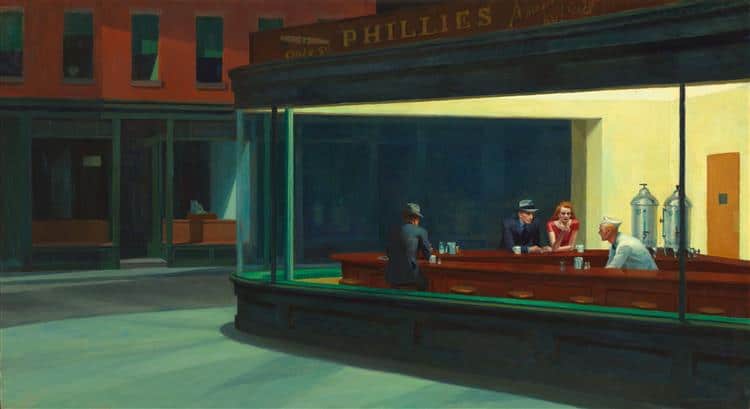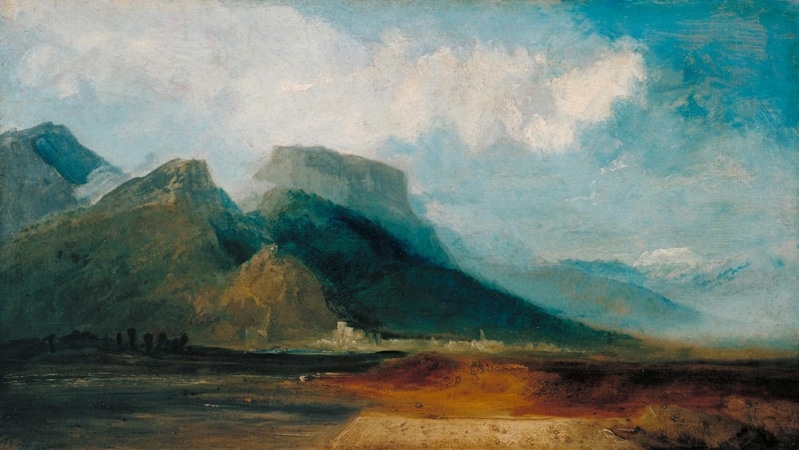Space in art can be used to create a sense of depth, or to guide the viewer’s eye through the composition.
Space is a fundamental element of art, alongside other fundamental elements like line, colour, value, shape, texture and form. Artists arrange these components to create aesthetically pleasing compositions and to create the illusion of realism.
Depending on how space is used in an artwork, artists can create compositional effects like a focal point, balance or a sense of movement. This all has an impact on the way in which the viewer receives the artwork.
Disclaimer: Fine Art Tutorials is a reader supported site. When you make purchases through links on this site, we may earn a small commission at no extra cost to you.
What is space in art?
Space in art refers to the visual area or environment created by a work of art. It is one of the most vital elements that artists use to create impactful works. This can refer to the space within an object, between objects. It can also refer to the negative space in an artwork which is devoid of subjects or objects. Therefore space in art is essentially the relationship between subjects and objects.
From the space in art, viewers can infer important information about the artwork and the environment. This is based on the relationship between subjects and objects. Artists use line, colour and space to create a sense of dimension, depth and perspective. For example, you can understand basic information about a subject, such as whether they are sitting, standing or lying down and the relationship to the surfaces and objects in the artwork.
The effect of space in art

By using space in art, the artist can emphasise a particular subject and create a focal point. Use space to lead the viewer’s eye in and to create a sense of rhythm in the art piece.
Space can be manipulated by artists to evoke a variety of emotions, from harmony to feelings of unease or tension. For example, multiple objects placed in close proximity can create a sense of unease, but it also creates unity and cohesion between those objects. Whereas objects more evenly space can create a sense of balance. In this painting by Edvard Munch, the house is the middle draws the eye in and the surrounding, clustered overlapping trees make the house seem shielded. This contrasts to the barren land in the distance, where Munch has left more space between elements. This gives the viewer an impression of the scale of the landscape, the solitude of the house and the barrier between safety and the unknown.
Composition and space in art

One of the most common ways that artists create the illusion of space in their work is through composition. By arranging objects, figures, or other elements within the frame in a certain way, artists can direct the viewer’s eye to certain points and create an illusion of depth and distance.
For example, objects will become gradually smaller as they recede into the distance. The most prominent figure in an artwork will likely be the largest and placed at the forefront compared to other objects and subjects.
Artists can use the rule of thirds to place their main subject or focal point at one of the three intersections of the canvas. This is where the viewer’s eye will likely be drawn first.
Three dimensional space and two dimensional space
When we look at a painting or image, it is important to distinguish between three-dimensional space and two-dimensional space. Three-dimensional space represents the real world, while two-dimensional space refers to the flat surface that artists are working on.
Three-dimensional spaces are dynamic, with objects appearing in different positions depending on your perspective. Artists can create the appearance of three dimensional space, with the use of space, line, value and colour.
Using linear perspective, one point or two point perspective, artists create a sense of deep space. Deep space is where there are levels of objects in a scene. For example, buildings in the distance and midground and people in the foreground.

Two-dimensional spaces, on the other hand, are static and do not change based on your viewpoint. In art two dimensional paintings are created with flat objects against flat backgrounds. Cubist paintings and some abstract artworks are a good example of paintings with shallow depth and the appearance of a two dimensional field.
Of course, artists can paint a single object on a flat white background and this will have less depth than a cityscape or landscape painting. The whitespace around the object brings it into focus, making it the main focal point of the piece.
Negative space and positive space

Positive and negative space is another way that artists can create a sense of depth in their work. Positive space refers to the objects or figures within an artwork. Negative spaces are all of the areas around and between these objects.
Artists use colour, line, and other visual elements to emphasise positive and negative space. Artists can use negative space by leaving parts of the canvas blank, or by using a background. When thinking of the composition of an artwork, the negative space around a subject or an object is often as important as the object itself. The negative space should appear balanced to give a harmonious feel. When objects are too close to one another, artworks begin to appear crowded.
Perspective in art

There are a number of different techniques that artists use to play with space in their artworks. One example is creating depth through perspective. Artists do this by establishing the foreground, middle ground, and background by using positioning or size differences. Painters use trompe l’oeil techniques to create the illusion of a three-dimensional scene within a two dimensional surface.
By using techniques like foreshortening or vanishing points, artists are able to create the illusion of depth.
Overall, artists use a variety of techniques to create dynamic compositions with deep space or flat, two-dimensional planes.
Focal point with use of space

One of the key elements of space in art is the focal point. This is the main area that we are drawn to when looking at an artwork. This can be a specific object, person, or element within the piece. An example could be a figure in a landscape painting or a brightly-coloured flower in an abstract work. In Edward Hopper’s painting ‘Nighthawks’, the light values and saturated tones of the room and three figures draw the eye. The background of buildings and the street which are more muted in tone act as white space, further emphasising the figures in the building.
The artist will often use the surrounding space to direct our attention towards this focal point, using techniques like contrast or balance to draw the viewer’s eye. For example, they may use a larger amount of space around the focal point to emphasise the figure. By creating areas of white or empty space around the focal point, they can bring attention to it without competing with other elements in the composition.
Famous examples of space in art

Some famous examples of space in art include M.C. Escher’s “Relativity”. Escher used multiple perspectives and geometric figures to create a seemingly infinite space that pulls the viewer into its depths. Vincent van Gogh’s “Starry Night” uses dramatic perspective and vibrant colour to create a sense of depth and movement.
Another artist that used space in their work interestingly is Piet Mondrian, who used the grid to create flat planes of bright colours separated by thin black lines. In each of these examples, the use of space creates a rich and complex visual experience that draws the viewer in and keeps them wanting more.

In the Renaissance art movement, artists began using linear perspective to create a sense of three dimensional space in their work. One of the most famous examples is “The Last Supper” by Leonardo da Vinci, where he employs vanishing points and perspective lines to create the illusion of depth.
How to use space in art

Space in art can be used in a variety of ways to create impactful and evocative works. Some techniques that artists use to manipulate space include creating depth through perspective, establishing the foreground, middle ground, and background by using compositional elements like size or positioning, and using trompe l’oeil techniques to create the illusion of a three-dimensional scene within the two-dimensional canvas. Overlap elements, size elements correctly or use values to create the illusion of space, perspective and depth. For example, Turner uses lighter values and blue colours to show the mountains receding into the distance to create atmospheric perspective in the mountains.
Finally
Overall, understanding how artists manipulate space in art can help us understand the message that they are trying to convey in their work. Whether you are an artist yourself or just someone who appreciates and loves art, understanding the role of space in art can help deepen your appreciation and understanding of this fundamental element of art. It can also help you to improve the compositions of your works and therefore improve your paintings overall.

